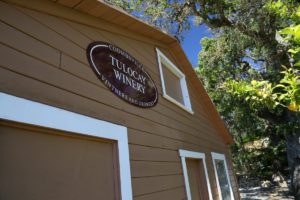

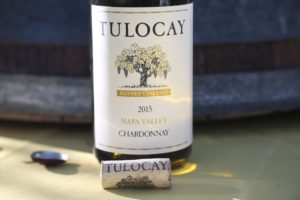 Tulocay Winery is the oldest continuously operating winery in Coombsville, a part of Napa Valley, located just north east of the actual town of Napa. Coombsville (named after Nathan Coombs, one of the founders of the city of Napa) is the newest one of Napa’s 17 sub appellations (approval granted in late 2011) – a region that is characterized by cooler growing conditions then further north in the valley and for featuring a wide diversity of micro-climates – allowing farmers to grow a variety of different types of grapes.
Tulocay Winery is the oldest continuously operating winery in Coombsville, a part of Napa Valley, located just north east of the actual town of Napa. Coombsville (named after Nathan Coombs, one of the founders of the city of Napa) is the newest one of Napa’s 17 sub appellations (approval granted in late 2011) – a region that is characterized by cooler growing conditions then further north in the valley and for featuring a wide diversity of micro-climates – allowing farmers to grow a variety of different types of grapes.
All of the Tulocay wines are from small single vineyards including Chardonnay, Pinot Noir, Cabernet Sauvignon, Petite Sirah, Syrah and Zinfandel (with a focus on grapes grown in Coombsville). The wines are typically 100% varietal. Most of the grapes used in Tulocay’s wines come from long term relationships that Bill has established over the years; Tulocay owns no vineyards. And in addition to the Napa Valley, Tulocay sources grapes from vineyard sites in other select locations in northern California.
After working on the long since defunct Pacific Coast Stock Exchange in San Francisco, founder Bill Cadman found himself in between jobs at age 29. He picked up a Sunset guide to wine country and started browsing the pages. The “wine country” north of San Francisco caught his eye. Bill came to the Napa Valley without any experience in the wine industry and took a job at Charles Krug Winery and began commuting in a 1955 Ford pickup from Sausalito to St. Helena.
Bill quickly picked up wine related knowledge and spent time working in the winery at Heitz Cellars (the old ghost winery at the end of Taplin Road, not the Heitz tasting room), Clos du Val, (all long time Napa wineries still in existence) and Robert Mondavi Winery where he worked for more than 20 years as a tour guide. He recalls walking into Robert’s wife, Margrit Mondavi’s office to introduce himself. She wanted to celebrate his hire by opening a glass of wine but she didn’t have any bottles in her office, so she poured Bill a glass of Tequila instead. He remembers being impressed by this gesture and thinking that he was going to have a fun time working at this winery.
He also remembers bringing visitors over to personally meet with Mr. Mondavi who would be hanging out at the winery. Mr. Mondavi was always interested in sharing his wealth of knowledge about the valley with visitors. Bill also recalls bringing his elderly mother into the winery for a celebration lunch of his 20 years working at the winery – Mr. Mondavi came over, pinched his mother’s cheeks and commented on how youthful her skin looked.


 Soon tiring of the commute he moved to the Napa Valley and purchased his home and winery site in 1972. Bill remembers his Napa County winery application form was merely two sides of one piece of paper. He founded Tulocay in 1975 using several buildings that were already on site at the time of his purchase. He was the winemaker during the first few years of building the brand in the 1970’s and over the years has had help from several others in the business including winemaker Mark Bunter. One day, Bill received a call from his daughter Brie indicating she was going to school at nearby Napa Valley College to learn more about oenology (after working other non-wine related jobs). This was excellent timing as Bill was getting up in years and was no longer able to do the physical work needed in the winery. In 2012 Brie took over wine-making duties and she has made all subsequent vintages (with plenty of input from Bill). Brie is also the assistant winemaker at another Napa based winery.
Soon tiring of the commute he moved to the Napa Valley and purchased his home and winery site in 1972. Bill remembers his Napa County winery application form was merely two sides of one piece of paper. He founded Tulocay in 1975 using several buildings that were already on site at the time of his purchase. He was the winemaker during the first few years of building the brand in the 1970’s and over the years has had help from several others in the business including winemaker Mark Bunter. One day, Bill received a call from his daughter Brie indicating she was going to school at nearby Napa Valley College to learn more about oenology (after working other non-wine related jobs). This was excellent timing as Bill was getting up in years and was no longer able to do the physical work needed in the winery. In 2012 Brie took over wine-making duties and she has made all subsequent vintages (with plenty of input from Bill). Brie is also the assistant winemaker at another Napa based winery.
Tulocay as Bill will tell you tongue in cheek, means “fine wines at reasonable prices” but in actuality it is an Indian word.
An experience at the winery is a step back into time to the mid 1970s when Napa was still relatively unknown on the international stage and all the flash and outside money had not yet soaked its way into Napa Valley. This is one of the best values in all of Napa for the quality of wine when compared to the pricing.
A tasting here is very relaxed and weather permitting is outside on a patio shaded by the oaks overlooking the small winery. Bill truly enjoys visiting with people and a tasting with him is a fun, at times humorous and always an educational experience with invaluable historical tidbits from a time when there were far fewer wineries in the Napa Valley.
For a low production winery Tulocay makes large variety of different types of wines. Until more recently, Bill worked with the historic and nearby Haynes Vineyard since his first vintage in 1975; his introduction to fruit from this vineyard was through a chance meeting with Louis Martini at a Napa Valley Wine Technical Committee picnic who ultimately introduced him to the owners of the vineyard at the time, Duncan and Pat Haynes. This vineyard was sold to Gaylon Lawrence, owner of Heitz Cellars in 2019.
The Haynes Vineyard (not to be confused with another historical vineyard by the name of Hayne Vineyard – owned by Chase Cellars in St. Helena) was first planted around 1966 under the tutelage of Louis M. Martini and André Tchelistcheff. These are certainly among the oldest if not the oldest continuously commercially producing Pinot Noir vines in all of Napa Valley.
Select Wines
The Tulocay Pinot Noir is not as rich or dense as one might find from some of the Napa Carneros Pinot Noir producers, rather it is more traditionally made – in a Burgundian style. Every year the wine from this variety tends to be elegant both in aroma and on the palate. Pinot Noir is partly what Tulocay is known for; remarkably for 45+ vintages Tulocay made Pinot Noir from the old vines in the Haynes Vineyard.


 The 2018 Tulocay Haynes Vineyard Pinot Noir is pale ruby in color; the bouquet initially offers notes of mushroom but quickly opens to cherry cola, raspberry, red licorice, wild strawberry, dried rose petal and old cedar box. The aromatics are slightly savory, although the fruit shows far more than any earthiness that this variety often displays. On the palate features flavors of dried herbs, cranberry and red cherry. Balanced, with some minerality nuances across the palate, this wine lingers with some darker spices and a very subtle hint of dried tobacco leaf. Prior to fermentation 85% of the grapes were destemmed leaving the remaining 15 percent as whole cluster. The wine saw no racking, no fining and no filtering.
The 2018 Tulocay Haynes Vineyard Pinot Noir is pale ruby in color; the bouquet initially offers notes of mushroom but quickly opens to cherry cola, raspberry, red licorice, wild strawberry, dried rose petal and old cedar box. The aromatics are slightly savory, although the fruit shows far more than any earthiness that this variety often displays. On the palate features flavors of dried herbs, cranberry and red cherry. Balanced, with some minerality nuances across the palate, this wine lingers with some darker spices and a very subtle hint of dried tobacco leaf. Prior to fermentation 85% of the grapes were destemmed leaving the remaining 15 percent as whole cluster. The wine saw no racking, no fining and no filtering.
Today, Tulocay produces two Chardonnay wines – the Cadman label which does not see any oak during its aging (featuring a photograph of his mother in her youth taken on Mills College in Oakland) and the Tulocay label, which is aged in both new and neutral oak barrels. The grapes for each of these wines are harvested and pressed at the same time. Tulocay’s first Chardonnay in 1975 was not from the Haynes Vineyard – rather it was sourced from a Chardonnay vineyard in Rutherford, off of Niebaum Lane (back when Rutherford had not yet been converted to mostly red grape varieties).
The 2019 Cadman Haynes Vineyard Chardonnay (saw no oak during fermentation or aging) is medium to deep gold color in the glass; offers bright aromatics of citrus blossom, lime, slightly under ripe pineapple, papaya, pineapple guava, lychee and mandarin. The aromatics are very pretty; one will not smell butter or oak in the glass – that is not this style of Chardonnay. Rounded and creamy across the palate, this wine offers generous and intense flavors including Golden Delicious apple, pear and mandarin. The acidity keeps this wine lively and fresh across the palate with a bright mouthwatering finish. We are not sure we could have identified this as a Napa Valley grown Chardonnay in a blind tasting. And in true Bill Cadman style, his notes on the back label tell it like it is, “Every harvest we aim to honor this site by making a Chardonnay that never touches those yucky, hard-to-clean wooden casks.”
The 2015 Tulocay Napa Valley Chardonnay is visibly golden in the glass – with notes of yellow pineapple, citrus blossom on the bouquet. Somewhat rounded on the palate, the wine shows a pleasing intensity of flavor along with mineralities. Excellent acidity and a clean finish. Drinks very well by itself.
The 2009 Tulocay Chardonnay was sourced from the Haynes Vineyard. This wine is golden yellow in the glass – this is not a Chardonnay that goes downhill after a few years. It is well made and drinks well after 5 years of age. In the glass it shows vibrant notes of yellow pineapple, red apple and citrus blossom, lemon and just a very subtle hint of white pepper. It is a complex yet elegant bouquet. On the palate it is silky smooth, balanced with a clean lingering finish that shows some mineralities. This is not an oak-driven wine.
The 2006 Tulocay Haynes Vineyard Napa Valley Syrah (tasted 17 years post vintage) is dark ruby in the glass with some brickish colors due to its age. The aromatics are highly tertiary and include scents of damp and dark earth, mushroom, leather, a nutty character including of dried walnuts, tobacco and dried blackberry. As the wine evolves in the glass two additional scents become quite noticeable: coffee grinds and espresso. If we were to characterize this bouquet at this age, we would use the word character to describe its layers and darker notes. The palate shows more fruit than the bouquet with flavors of dried blackberry and other dark berries, plum dark chocolate and toffee. The tannins are supple, resolved and well integrated into the finish. This wine lingers with a light but persistent dryness underneath the tongue towards the back of the palate. While listed as 16% alcohol, its overall feel is fairly well balanced but you may feel unbalanced if you consume the entire bottle too quickly.


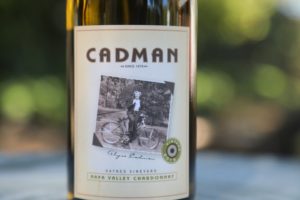 Bill makes a lighter styled Cabernet Sauvignon which unlike much of the Napa Valley actually showcases the characteristics of this variety. Over the years the source vineyard has changed but the style of wine has not – often lower alcohol, higher acid and hints of the herbal qualities inherent in this variety. Tulocay produced a Cliff Vineyard designate Cabernet Sauvignon for several decades. The 2002 Tulocay Cabernet Sauvignon show dark ruby color with a nose containing notes of smokiness and hints of oak. Offers balance and restraint across the palate with a smooth and supple mouth feel. The tannins are not gripping nor are they course in any way.
Bill makes a lighter styled Cabernet Sauvignon which unlike much of the Napa Valley actually showcases the characteristics of this variety. Over the years the source vineyard has changed but the style of wine has not – often lower alcohol, higher acid and hints of the herbal qualities inherent in this variety. Tulocay produced a Cliff Vineyard designate Cabernet Sauvignon for several decades. The 2002 Tulocay Cabernet Sauvignon show dark ruby color with a nose containing notes of smokiness and hints of oak. Offers balance and restraint across the palate with a smooth and supple mouth feel. The tannins are not gripping nor are they course in any way.
According to Bill, Casanova Zinfandel was one of the best wines he made, but the last vintage of this was 2002 and was only available for purchase at the winery. The fruit source for this wine was key as it was from that ‘magical’ red ground on the eastern slopes of the Oakville Appellation just below Pritchard Hill. This part of Napa Valley is home to numerous premium wineries including Dalla Valle and Oakville Ranch among others.
Tulocay made a Zinfandel from Amador County grown grapes for a number of years. Starting with the 2013 vintage, they sourced Zinfandel for several years from a historical vineyard on Dunaweal Lane in Calistoga from old head pruned vines. Celebrating the spirit of Zinfandel, this is the one wine that tends to be significantly higher in alcohol compared to the other Tulocay wines – helped in part by its warmer growing climate in the northern part of the valley. Regardless, their Zinfandels tend to have good acidity.
The 2018 Tulocay Dr. Pickett Vineyard Zinfandel (located appropriately off of Zinfandel Lane in St. Helena) is medium ruby in color; offers plenty of fruit on the bouquet including blackberry, dark cherry and a sweet aromatic thread of black licorice. Accompanying the fruit notes are aromas of old cedar box and white pepper. And as the wine evolves further, offers aromas of mocha and espresso. Shows plenty of brightness across the palate with both red and darker cherry flavors. Mouthwatering. Lingers with darker spices including cracked peppercorn, cedar and earthy slightly dry tannins with a light to moderate grip. The finish is quite savory.
—
One aspect which differentiates Tulocay from almost all Napa wineries is their wines are typically 3-4 years older than other wineries’ current vintages and at the time of our latest visit, the wines we were tasting were five and six years old – certainly not a bad thing for consumers. Consumers can also take note that these wines are not priced higher despite the additional aging. Even a variety that is often the highest priced in the valley, Cabernet Sauvignon, is reasonably priced.
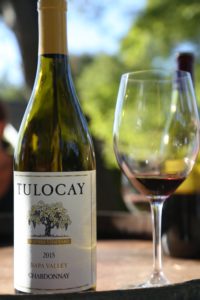 Bill’s philosophy about wine is refreshing; it should be enjoyed by family and friends, rather than as a social status to show off to others.
Bill’s philosophy about wine is refreshing; it should be enjoyed by family and friends, rather than as a social status to show off to others.
In 1988 Bill received a menu in the mail – it was from the US Federal Government containing a dinner menu dated Thursday April 21, 1988; his wines had been served at a dinner at the White House along with wines from Schramsberg and from Robert Mondavi. This was certainly a nice feeling to see one’s wine alongside Robert Mondavi, especially considering Bill worked for Mr. Mondavi for 20 years.
Rather than drilling a fancy cave on site, Tulocay’s “cave” is a C-Train storage unit, but it does contain a “flying bat” – as Bill says, “to help make the “cave” more authentic”. When deciding on a design for the label, Bill realized it was probably best not to use an outline of his fairly rustic looking physical winery. Rather he chose to display an image of an old grapevine loaded with grapes. John Farrel of the design firm, Colonna-Farrell created the image for the Tulocay label, a prolific design firm, active from 1975 through 1997. And Bill ripped out a magazine ad for Cutty Sark to use as an example of a font he wanted to mimic for the word ‘Tulocay’ on his wine label.
The winery is small but functional for their limited production wines (around 1,000 cases a year). For more information and to join their wine club, visit: www.tulocay.com
Winery
Tulocay Cemetery
Wine with Tony






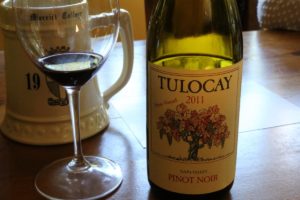




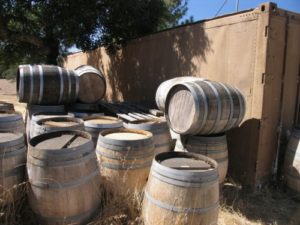
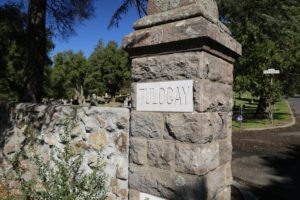



TONY, AS YOU MAY KNOW, I HAVE AND HAVE ACCESS TO MANY OF NAPA VALLEY’S BEST (AND WORST) WINES. I DRINK THE TULOCAY 2002 AMADOR ZINFANDEL ANYTIME I WANT A “MANLY WINE”, AND I DRINK THE TULOCAY 2007 SYRRAH ANYTIME I WANT A “REAL’ THRILL OR IF I AM HAVING SOME SERIOUS WINEMAKER TYPES OVER FOR LUNCH OR DINNER. BOTH WINES ARE FROM A BYGONE ERA…HONEST, FRUIT FORWARD, TERROIR (THERE GO THE ANTI-FR TYPES!~ EXPRESSION), DENSE, DARK, SOLID, THE WINE COMES FIRST WINE MAKING!!! NO HOMAGE TO GUYS IN SUITS WITH PENS, EDITORS AND AGENDAS IN MIND. DRINK RED MY FRIEND, STAY HEALTHY..
Tony Mori is one of the video godfathers of the Napa Valley 🙂 That guy really gets around!